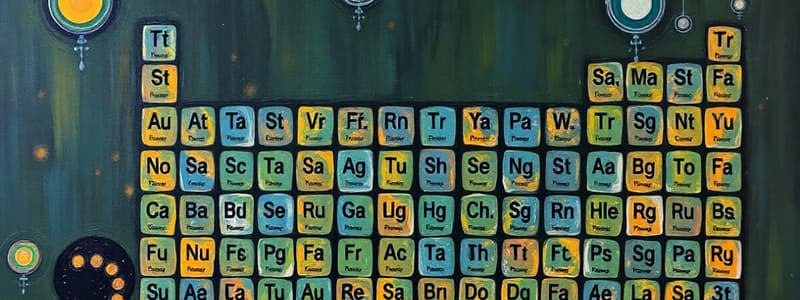Podcast
Questions and Answers
Which element is known for being highly flammable and is commonly used in fuel cells?
Which element is known for being highly flammable and is commonly used in fuel cells?
- Neon
- Hydrogen (correct)
- Nitrogen
- Helium
Which element is a soft, silver-white metal that reacts with water and is primarily used in batteries?
Which element is a soft, silver-white metal that reacts with water and is primarily used in batteries?
- Lithium (correct)
- Beryllium
- Boron
- Carbon
What is the primary use of fluorine, the most electronegative element?
What is the primary use of fluorine, the most electronegative element?
- Production of organic compounds
- Aerospace components
- Fluorides in dental products (correct)
- Creating alloys
Which element constitutes approximately 78% of Earth's atmosphere and is non-reactive at room temperature?
Which element constitutes approximately 78% of Earth's atmosphere and is non-reactive at room temperature?
Which element is characterized by being a noble gas and is often utilized in neon signs?
Which element is characterized by being a noble gas and is often utilized in neon signs?
Flashcards are hidden until you start studying
Study Notes
Atomic Number 1 to 10
-
Hydrogen (H)
- Atomic Number: 1
- Atomic Mass: 1.008 u
- Properties: Colorless, odorless gas; highly flammable.
- Common Uses: Fuel cells, fertilizers.
-
Helium (He)
- Atomic Number: 2
- Atomic Mass: 4.0026 u
- Properties: Colorless, odorless gas; non-flammable; noble gas.
- Common Uses: Balloons, cryogenics.
-
Lithium (Li)
- Atomic Number: 3
- Atomic Mass: 6.94 u
- Properties: Soft, silver-white metal; reactive with water.
- Common Uses: Batteries, mood-stabilizing drugs.
-
Beryllium (Be)
- Atomic Number: 4
- Atomic Mass: 9.0122 u
- Properties: Hard, gray metal; high melting point; toxic.
- Common Uses: Aerospace components, X-ray windows.
-
Boron (B)
- Atomic Number: 5
- Atomic Mass: 10.81 u
- Properties: Metalloids; hard, black-brown solid; semiconductor.
- Common Uses: Glass, detergents, neutron capture.
-
Carbon (C)
- Atomic Number: 6
- Atomic Mass: 12.011 u
- Properties: Non-metal; exists in multiple allotropes (e.g., graphite, diamond).
- Common Uses: Organic compounds, fuels, steel production.
-
Nitrogen (N)
- Atomic Number: 7
- Atomic Mass: 14.007 u
- Properties: Colorless, odorless gas; makes up 78% of Earth's atmosphere.
- Common Uses: Fertilizers, explosives.
-
Oxygen (O)
- Atomic Number: 8
- Atomic Mass: 15.999 u
- Properties: Colorless gas; essential for respiration; highly reactive.
- Common Uses: Respiration, water (H2O), oxidation processes.
-
Fluorine (F)
- Atomic Number: 9
- Atomic Mass: 18.998 u
- Properties: Pale yellow gas; most electronegative element; highly reactive.
- Common Uses: Fluoride in dental products, Teflon.
-
Neon (Ne)
- Atomic Number: 10
- Atomic Mass: 20.1797 u
- Properties: Colorless, odorless gas; noble gas; inert.
- Common Uses: Neon signs, high-voltage indicators.
Elements 1 - 10
-
Hydrogen (H) is the lightest element and the most abundant element in the universe. It's a colorless and odorless gas that is highly flammable and used in fuel cells and fertilizers.
-
Helium (He) is a colorless and odorless noble gas that's non-flammable and used in balloons and cryogenics. Helium also makes up a small portion of the Earth's atmosphere.
-
Lithium (Li) is a soft, silver-white metal that reacts with water. It's used in batteries and mood-stabilizing drugs.
-
Beryllium (Be) is a hard, gray metal with a high melting point. It's toxic but used in aerospace components and X-ray windows.
-
Boron (B) is a metalloid that is hard and black-brown. It's a semiconductor and commonly used in glass, detergents, and neutron capture.
-
Carbon (C) is a non-metal that can exist in different structures, such as graphite and diamond. It's the basis of organic compounds and used as fuel and in steel production.
-
Nitrogen (N) makes up the majority of the Earth's atmosphere. It's a colorless and odorless gas and used in fertilizers and explosives.
-
Oxygen (O) is essential for respiration and is a colorless gas highly reactive. It's used in the creation of water (H2O) and oxidation processes.
-
Fluorine (F) is the most electronegative element and a pale yellow gas that is very reactive. It's used in dental products and the production of Teflon.
-
Neon (Ne) is a colorless and odorless noble gas that is inert. It's commonly used in neon signs and high-voltage indicators.
Studying That Suits You
Use AI to generate personalized quizzes and flashcards to suit your learning preferences.




